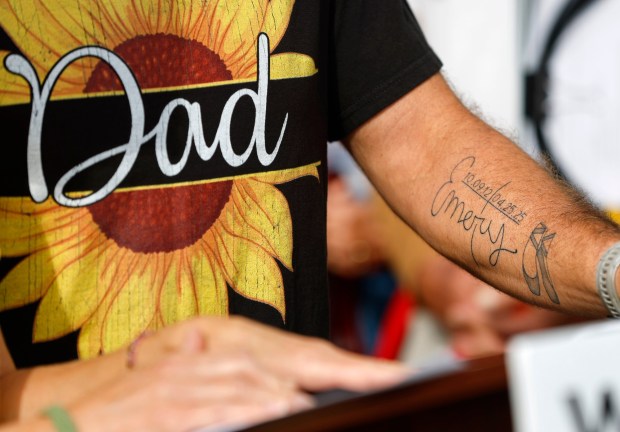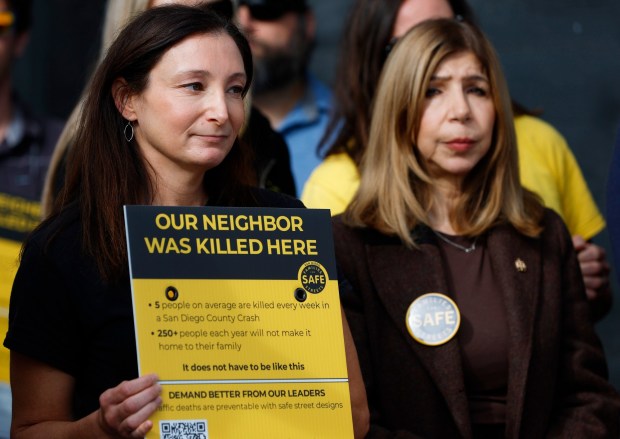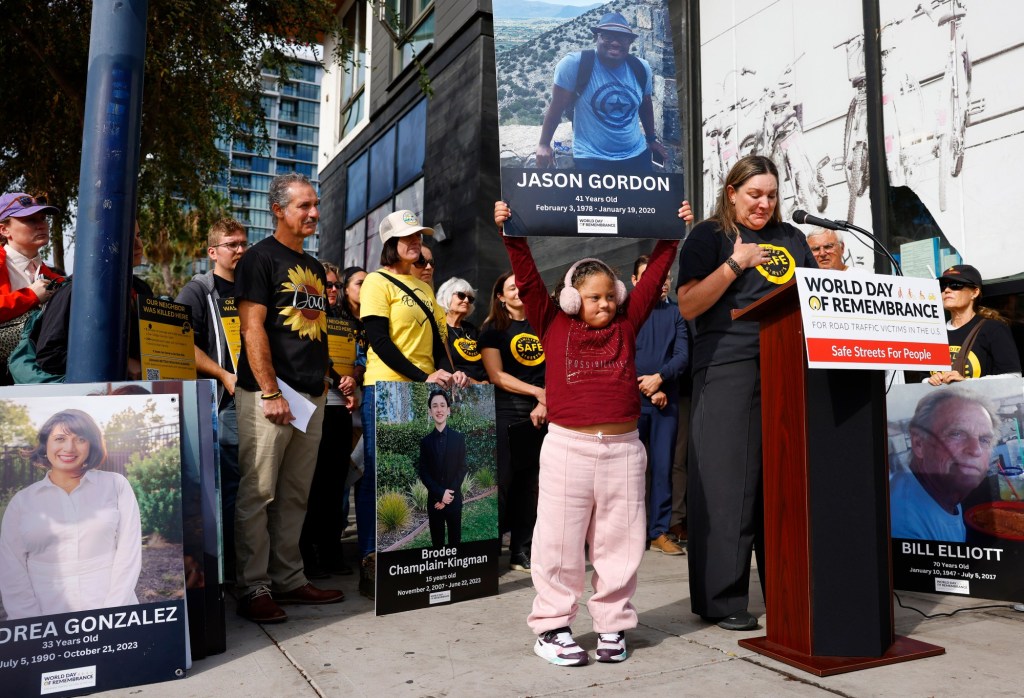Advocates for the safety of pedestrians and cyclists fanned out across the region Sunday to mark the sites of recent crash deaths and raise awareness of safety challenges.
Their effort was part of World Day of Remembrance for Road Traffic Victims, a global event San Diego is participating in for the fourth consecutive year.
The event included a news conference where family members of crash victims talked about their pain and lobbied for solutions like lower speed limits and new safety features at notoriously dangerous intersections.
“We know where the most dangerous streets are and we know the solutions,” said Laura Keenan of Families for Safe Streets San Diego, a nonprofit spearheading the effort. “What we need is the political will.”
Volunteers and safety advocates placed signs saying “Our Neighbor Was Killed Here” at 146 locations in the city of San Diego and 13 locations in Encinitas – spots where crashes have taken lives in the last two years.
Co-sponsors of the local event include Families for Safe Streets Encinitas, the San Diego County Bicycle Coalition and Circulate San Diego.
Bridget Chalekian of Safe Streets Encinitas lobbied for speed limit reductions in her community.
“It’s three times more likely a pedestrian will survive if struck by a vehicle that is traveling 30 mph versus one that is traveling 40 mph,” she said. “That seems like a pretty reasonable exchange.”
Chloe Lauer, executive director of the bicycle coalition, said the advocacy goes beyond saving lives.
“We fight every day for bicycling and walking to be safe, viable forms of transportation and recreation,” she said.
The effort comes as the city of San Diego is doubling down on a 10-year-old safety campaign called Vision Zero despite some disappointing results.
 John Chalekian, who has a tattoo in honor of his daughter Emery, speaks at an event to observe World Day of Remembrance for Road Traffic Victims on Nov. 16, 2025 in San Diego, CA. HIs daughter, Emery Chalekian, 12, was killed while crossing Encinitas Boulevard in a marked crosswalk in April. (K.C. Alfred / The San Diego Union-Tribune)
John Chalekian, who has a tattoo in honor of his daughter Emery, speaks at an event to observe World Day of Remembrance for Road Traffic Victims on Nov. 16, 2025 in San Diego, CA. HIs daughter, Emery Chalekian, 12, was killed while crossing Encinitas Boulevard in a marked crosswalk in April. (K.C. Alfred / The San Diego Union-Tribune)
Annual crashes with severe injuries have remained mostly flat since San Diego launched Vision Zero in 2015, hovering around 150 with a high of 184 in 2018 and a low of 113 during the pandemic in 2020.
And deaths have actually risen — from 46 in 2014 to 67 in 2021, 69 in 2022 and 70 in 2023.
City officials say the answer is spending more money because pedestrian and cyclist safety is particularly important in San Diego, where plans for more high-rise buildings and congestion make alternate commuting options like walking and cycling crucial.
The city plans to increase its annual spending on Vision Zero beyond the $26.7 million per year on average since its launch. A new plan calls for nearly $200 million over the next five years for more comprehensive efforts.
They include hundreds of new roundabouts, refuge islands, flashing beacons, countdown timers, widened crosswalks and pedestrian-friendly “delayed green” stoplights.
Many of those upgrades will come at crash sites where people lost their lives.
“All the fatal crashes that we are memorializing today are preventable,” said Michelle Gonzalez, whose sister Andrea was killed in a crash in 2023 at age 33. “If our leaders had acted on the statistics and the science, many of our loved ones would still be here with us today.”
Katie Gordon, whose husband Jason was killed at the notoriously dangerous intersection of Market and 19th streets in San Diego, said local leaders must do more.
“We have the power to prevent this, we have the responsibility to prevent this,” she said.
In addition to intersection upgrades, the city of San Diego is analyzing 500 intersections that have characteristics similar to ones where people have been killed in vehicle crashes.
The goal is figuring out the traits shared by those intersections where nobody has died so officials can determine what changes to make at the deadly ones.
The city is also aggressively enforcing the state’s daylighting law, which makes it illegal to park within 20 feet of an intersection because that can reduce visibility and cause crashes.
But Council President Joe LaCava, who attended Sunday’s event, acknowledged that more must be done.
“It’s a little bit of a kick in the butt for me,” LaCava said of hearing the calls for action.
He said city efforts to reduce speed limits must go further. The city has focused mostly on commercial areas, but LaCava said they must also reduce speed limits in more residential areas.
LaCava said he attended the event to send the message to the families of victims that elected leaders are listening.
“It offers a little bit of solace to the families to know that there are people actually paying attention to this,” he said.
 Laura Keenan, founder of Families for Safe Streets San Diego, and San Diego County District Attorney Summer Stephan listen during an event to observe World Day of Remembrance for Road Traffic Victims. Keenan’s husband Matt was hit and killed by a wrong-way driver riding his bike in Mission Valley in 2021. (K.C. Alfred / The San Diego Union-Tribune)
Laura Keenan, founder of Families for Safe Streets San Diego, and San Diego County District Attorney Summer Stephan listen during an event to observe World Day of Remembrance for Road Traffic Victims. Keenan’s husband Matt was hit and killed by a wrong-way driver riding his bike in Mission Valley in 2021. (K.C. Alfred / The San Diego Union-Tribune)
Keenan said advocacy must continue.
“Because these deaths are happening one at a time on different streets in different neighborhoods, we’re expected to accept them as normal,” she said. “These deaths are not inevitable. We have the power to stop them.”
She said the signs being placed in 159 locations on Sunday are part of the process.
“Placing signs honors lives, but it is also a call to action.”
